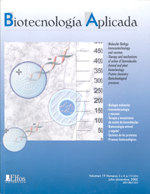
|
Biotecnologia Aplicada
Elfos Scientiae
ISSN: 0684-4551
Vol. 14, No. 3, 1997, pp. 163-168
|
 Bioline Code: ba97038
Bioline Code: ba97038
Full paper language: English
Document type: Research Article
Document available free of charge
|
|
|
Biotecnologia Aplicada, Vol. 14, No. 3, 1997, pp. 163-168
| en |
The effect of the epidermal growth factor treatment schedule on the healing of full-thickness wounds in pigs
Berlanga, Jorge; Lodos, Jorge; Labarta, Violeta; Merino, Nelson; Gonzalez, Tania; Hayes, Orlando; Puentes, Pedro; Mulet, Julio & Lopez-Saura, Pedro
Abstract
The pharmacodynamic effect of different epidermal growth factor (EGF) application frequencies on the healing of full thickness skin wound biopsies (8 mm diameter) in pigs is studied. A total of 100 wounds were created, grouped and medicated as: I, II, III treated with an EGF-containing formulation (EGF 10 ug/g plus 1 % silver sulfadiazine) every 24, 48 and 72 h, respectively. Medicated-control wounds (IV) were treated every 24 h with 1 % silver sulfadiazine, and group V was the non-medicated control. Dressings were changed every day and wounds were cleansed and treated accordingly. Wounded tissue was harvested on day 8, and used for histologic examination or computerized-assisted planimetry (10/10 wounds). Percentage of total re-epithelized area, medium radius, circularity factor, wound perimeter, epithelial linear ingrowth, dermal reconstitution, epithelial migration, and wound contraction were considered. EGF-daily treated wounds had a total re-epithelization of 80 %. It was significantly stimulated as compared to the others (p < 0.05). Similarly, group I had the largest rate of epithelial linear ingrowth and the lowest values of medium radius and wound perimeter (p < 0.05). Epithelial migration was significantly stimulated (p < 0.05) in the EGF-treated groups irrespective of the treatment frequency as compared to group IV. The lowest value in the circularity factor was detected in group I (p < 0.05). Dermis reconstitution was significantly improved in groups I and II in relation to group IV (p < 0.05), but wound contraction was not modified. We showed that EGF promotes wound repair on the basis of frequently repeated exposures to the target tissue.
Keywords
EGF, re-epithelization, dermal reconstitution
|
| |
| es |
Berlanga, Jorge; Lodos, Jorge; Labarta, Violeta; Merino, Nelson; Gonzalez, Tania; Hayes, Orlando; Puentes, Pedro; Mulet, Julio & Lopez-Saura, Pedro
Resumen
Se estudio la respuesta reparativa de lesiones de grosor total en cerdos ante variaciones en la frecuencia de aplicacion de una formulacion con factor de crecimiento epidermico (FCE, 10 ug/g) y sulfadiacina de plata 1 %. Se indujeron 100 lesiones de 8 mm que se agruparon y trataron como: I, II, III, tratados con FCE cada 24, 48 y 72 h, respectivamente. Los grupos IV y V fueron controles medicado y espontaneo. Los animales se sacrificaron al octavo dia y se colectaron las ulceras para estudio histologico o planimetrico (10/10). Se estudiaron los siguientes parametros: porciento de area total reepitelizada, radio medio, factor de circularidad, perimetro, crecimiento lineal del epitelio, reconstitucion dermica, migracion epitelial, e indice de contraccion. Las heridas del grupo I mostraron un 80 % de reepitelizacion total, la que fue significativamente superior al resto de los grupos (p < 0,05). Estas mostraron el mayor nivel de crecimiento lineal y los menores valores de radio medio y perimetro con respecto a los otros grupos (p < 0,05). Se constato un incremento significativo de la migracion en todos los grupos tratados con FCE con relacion al grupo IV, (p < 0,05). La circularidad fue significativamente menor en el grupo I con relacion a los otros grupos (p < 0,05). La reconstitucion de la dermis fue significativamente superior en los grupos I y II con respecto al IV (p < 0,05). No se demostraron diferencias en el nivel de contraccion de las heridas. Este experimento demostro que el FCE estimula la reparacion cutanea de forma frecuencia de tratamiento-dependiente.
Palabras-clave
FCE, reepitelizacion, reconstitucion dermica
|
| |
© Copyright 1997 Elfos Scientiae
Alternative site location: http://elfosscientiae.cigb.edu.cu/Archivo.asp?Id=6
|
|
